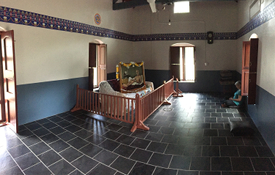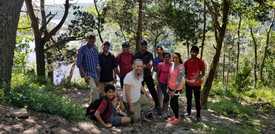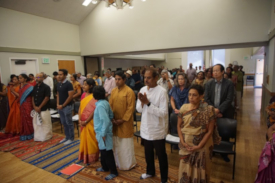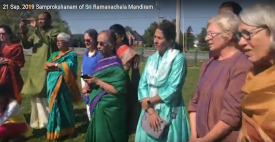Sri Krishnaprem’s Visit to Sri Ramana Maharshi, Part IV
We continue with the story told by the devotee of Bhagavan who arranged for the South Indian tour of Sri Krishnaprem, who is called 'Gopalda' in this narration. After leaving Sri Ramanasramam and visiting Pondicherry, their train sets out for Madura. It appears wherever they travel some reference to the Maharshi is made, perhaps because he was known to have taken much interest in Sri Krishnaprem and his South Indian tour.
The guard blew his whistle and waved the green flag and the train from Pondicherry started with a groan. Just at that very moment the train from Tiruvanamalai arrived and Balarama Reddy ran across the platform and boarded the departing train. Late that night we reached the house of Ramana’s devotees at Sri Rangam. They were happy to get the chance to be of some service to Gopalda. Next morning, Gopalda, Upadhyaya and I went to the temple. It was a bit early, and no devotees had yet arrived. The door of the inner temple was closed, and a solitary person was playing the veena before the closed door. We three sat on the opposite side, with Gopalda in the middle. Gopalda’s eyes were closed. It really was a wonderful atmosphere.
Within a few minutes we noticed that Gopalda’s body was oscillating like the pendulum of a wall clock. When this oscillating or swinging motion became more pronounced, I started feeling rather uncomfortable. I passed my hand round the back of Gopalda’s swinging body and poked my finger at Upadhyaya to draw his attention to what was happening. He was aware of it too.
Then the door of the temple was opened. Gopalda could hardly walk those few steps to reach the door. Upadhyaya and I were on either side of him when the unexpected thing happened. Gopalda’s body just collapsed and fell with a terrible bang on the raised stone platform, similar to a window lintel. This raised stone structure (chowkät in Bengali) was covered with thin brass plates embossed with flower design. The purohit and other devotees all cried out in horror. The purohit said that if the blood of such a mahatma were spilt, it would bring about a great disaster. Thank God, Gopalda was unhurt. Upadhyaya and I supported Gopalda and dragged him back, holding him up because he could not stand. After resting for a while, he regained his normal physical powers and we made our way to our temporary residence.
I will set down here what Gopalda told me afterwards. At first he saw that there was nothing absolutely nothing. And that void was filled with utter, total darkness. Then a tiny lotus sprouted in the midst of that complete nothingness - the first sign of manifestation. That tiny lotus started growing bigger, bigger, and still bigger. It went on growing until it covered the empty void completely. Right at the middle of that gigantic lotus there appeared the dual images – lifesize – of Sri Radha and Sri Krishna. They stood motionless with a smile on their faces. And on each of those hundreds of thousands of petals the dual figures of Radha and Krishna appeared, but smaller and rotating and dancing endlessly.
At Gopalda’s behest, I later narrated this account to Ramana Maharshi. Ramana observed, “His experience was correct. What he saw depicts the two-fold phenomenon of the eternal, motionless, unchangeable, and the play or lila with manifestation.” Then the Maharshi told me that on that particular day when Gopalda was present, the puja at Sri Rangam had been done with the sankalpa (literally a resolve) of depicting how manifestation arose out of the unmanifest – a sort of Viswarupa darshan. Of course, he concluded his remarks with, ” Was this experience independent of or outside his atma-satta?”
I admit I was extremely curious to find out with what sankalpa the puja had been conducted on that particular morning. So I wrote to our erstwhile host at Sri Rangam, and requested him to enquire and ascertain the truth or otherwise of the above statement. In due course the reply came that what the Maharshi said was literally correct. Fool that I was, I had not accepted his words outright.
So we took leave of our host and his family and boarded a train for the second leg of our pilgrimage, namely to Madura, where stands Meenakshi Devi’s temple. Our numbers had swelled from three to five by the addition of Asher Bhai from Pondicherry and Balarama Reddy from Villupuram Junction. I had no inkling of what awaited us at Madura. Nor, of course, could the other three friends and fellow travellers have guessed anything beforehand. How about Gopalda? I don’t know and can’t say.
From the point of view of spiritual experience, Gopalda’s trip to Madura and Rameswaram does not claim any special consideration. In due course Gopalda had Meenakshi Devi’s darshan. There was no crowd. Gopalda prostrated himself before the murti in the dusty hall. And that was all that happened.
But from another angle of vision, this trip to Madura and Rameswaram undoubtedly supplied two very important cogs, without which the gorgeous wheel would have lost much of its grandeur and amazement.
One fine morning found the five of us stranded on the station platform at Madura. The person who had been contacted by the Ramanashram authorities and asked to meet us at the station and take us to the house where the Maharshi had had his realisation was not there.
After some time of waiting it became clear that we would have to fend for ourselves. At first it was suggested that we take shelter in the station waiting room while Balarama went to the house to ascertain the situation. But Asher Bhai told Gopalda that instead of waiting at the station we should take our rest at the home of a friend he had in the town. He also pointed out that we could take our bath and meal there and then plan our next move when Balarama got back from his mission.
Balarama seemed not to be in favour of this decision but gave in when Gopalda accepted. So we were duly taken to his friend and had our bath. Meanwhile Balarama returned from his investigation and informed us that the caretaker had gone away to his home and the house was locked and chained. However, we were taken to the house and saw the large photograph of Sri Maharshi through the slats of the front door.
It is interesting to note that from this point on it was Asher Bhai who acted as our doyen; he arranged our travelling routine, where we would stay and with whom, and last but not least, he also got Gopalda’s permission to pay our railway fares, etc. until we returned to Pondicherry.
At this point I must mention that Gopalda here informed us that his stomach was upset, but he refused to consult any doctor. Seemingly, it was not all that serious. In due time, therefore, we set off on the third and last leg of our southern trip Rameswaram.
When we reached Rameswaram station we proceeded with our bundles and bags to the dharmashala that was run by a Gujarati friend of Asher Bhai. Gopalda said he would go straight to the temple. Balarama also went ahead to meet with the temple authorities to obtain permission for Gopalda to enter the inner sanctum of the temple. Gopalda was a Westerner and under normal circumstances that was never allowed.
Gopalda, Upadhyaya and I set off for the temple. I thought we would probably never see the lingam since the temple corridor we had to negotiate appeared to be endless. I personally found it difficult to keep pace with Gopalda’s rapid steps. He appeared to be in a hurry.
At long last we reached the sanctum sanctorum. I don’t think I expected anything out of the ordinary to happen, but I was wrong. What did happen could be described as another near miracle. The door of the wooden structure enclosing the lingam was open. Not a soul was in sight. Gopalda dashed inside and hurriedly removed the flowers, leaves, etc. covering the top of the lingam, merged in water. He fished out two small phials of water and poured them on the lingam. One of them, I know, contained sacred water from the holy spring at Badrinath collected by Moti Rani three years earlier and kept for this purpose.
Upadhyaya followed suit, and I believe I rubbed my hand on the exposed top of the lingam. I don’t remember properly; I was moving in a sort of haze. How very, very happy Gopalda looked.
And then came the pathos. We had walked only a few steps from the inner sanctum and were wondering what to do next when along came Balarama and the temple authorities. After the formal introductions and salutations were over, the administrators cleared their throats and started saying something. Actually, they stuttered and stammered. One could feel sorry for them, for they were obviously unhappy. They started saying, “Sir, you must forgive us... We just don’t know how to mention that.... You will realise that...” and so on. Gopalda waited patiently.
Then he put them at ease by saying, “Please don't hesitate to say what you must say.” So eventually these unhappy persons blurted out the old, old religious superstitions dogma. “Oh! How can a yavana (foreigner) be allowed to set his eyes upon God, much less touch him?” Gopalda again rose to the occasion. Once again he put these people to shame by assuring them they were quite right. Next, they invited Gopalda to come and have a look at the god's treasure house - the jewellery, gold nuggets and what not. Gopalda again put them at their ease by expressing his gratitude but declined the offer. Then they requested Gopalda to wait for a little so that the chariot drawn by many bulls could be made ready and he could pass through the town in ceremony. Gopalda refused politely by saying that he was a poor Vaishnava and that he preferred to walk. The farce came to an end.
Later, when I told Balarama what had happened in the sanctum sanctorum, he was suitably amazed. And much later still, when I came to recount this episode to the Maharshi, he appeared to enjoy it heartily. He said, “That is just like the Lord. First He gives you darshan and then later says you can't have it.”
When he left the temple, Gopalda said he would like to have a dip in the back bay, and when he reached the seashore he plunged into the water and kept swimming. There was no denying that he was thoroughly happy swimming.
Sri Ramana Jayanti Retreat in Tampa
Sun 29 Dec – Wed 01 Jan

This year's retreat will again have periods of meditation, chanting, readings, presentations, satsang and quiet time for reflection and relaxation, and will again take place at the Franciscan Center in Tampa, Florida. Additional programs will be held at the new Old Hall and the Hindu Temple, both located on Lynn Road in Tampa. A program to engage the children in spiritually-oriented activities is also scheduled. Participants are requested to arrive Sunday afternoon by 3 P.M. to attend the special Arunachala-Ramana puja at the Hindu Temple together with a program in the new Old Hall.
For more information and a registration form, please contact the ashrama.The Franciscan Center's accommodation capacity is limited to 65 guests. The final registration date is November 30th. Details related to the cost for lodging and food will be provided along with the registration form.
The retreat will be held at:3010 North Perry Avenue
Tampa, FL 33603-5345
A Trek to the Summit
Hari Moorthy of New Jersey reports on how each step of a June hike to the summit of Mount Tammany transported the hikers up into the inspired heights of Sri Ramana Bhagavan's sannidhi. This is what is called ‘Ramana satsang’
With Bhagavan's grace, we all had a great time in NJ this past weekend. Our New Jersey Ramana Satsang had planned a hike to Mt.Tammany a number of weeks ago. At the last minute, a number of friends couldn't join owing to various obligations. Instead, Bhagavan executed His plan by sending Arthur and Suresh to join us on this hike. The constraints around when we should go and be back all dropped away of their own accord, which was yet another act of Bhagavan's grace.
Eight of us started out in a single van from West Windsor, New Jersey on Saturday morning.The topic of discussion on the way to the climb was Major Chadwick, with readings from a book relating to his first meeting with Bhagavan. Segments of this book read by Swaminathan in the car completely erased any burden we would normally have felt while following a huge and slow truck on a single-lane road for about 50 miles. Upon arriving at the parking lot, Lavanya fed us a light snack consisting of sandwiches. Suresh and Arthur also arrived from New Hampshire within 20 minutes and the hike began around 12 p.m.
It was just a beautiful satsang on Bhagavan, with His grace, Arthur's story, Lavanya's dream and all. We were mostly led by Rishabha who had taken an instant liking to the rocks on the mountain, and seemed to have a very familiar time with it all. The trail isn't smooth and largely has disheveled rocks and many steep climbs. Along the way, Suresh's presence attracted a mama bear [1] and a few of her cubs for our darshan. When we did this same hike a year ago it had taken us three hours with plenty of gasping for air and some even couldn't manage to reach peak. This time we were up at the top within an hour-and-a-half. We didn't rush at any point and took plenty of rest along the way. Every member of our hiking satsang felt the Divine Presence, for it had been very easy to reach the top. And there we experienced a beautiful breeze.
As we sat on its peak overlooking a beautiful river flowing 2200 feet below, another conversation on what brought Swami and Suresh to Bhagavan ensued. After an hour, we climbed down and arrived at the parking lot about 3:30 p.m. Lavanya gave us all some home-cooked rotis and subji – the first real meal of the day for most of us.We drove back and assembled at our home for dinner, where Lavanya served us some channa and rotis around 8 p.m.
The evening discussion was around Bharathiyar, Shankara and Bhagavan's influence on his devotees. It was a day to be remembered, for we all felt like fish in a grace-filled lake. The next day we had an early morning homam organized by Lavanya. We were blessed for Suresh and Arthur were in attendance. Around 11 a.m. devotees gathered in our home for our monthly Sri Ramana Satsang. Both Lavanya and Sangeetha sang the most beautiful songs. The entire day was spent with meditation, prayer and Sri Bhagavan's grace which was abundantly showered on all his children.
In the course of an informal converstion, Sri Bhagavan pointed out that Self-realisation is possible only for the fit. The vasanas must be eliminated before jnana dawns. One must be like Janaka for Jnana to dawn. One must be ready to sacrifice everything for Truth. Complete renunciation is the index of fitness.
Headline Poems of Bhagavan Sri Ramana Maharshi
Bhagavan, on occasion, would compose a new poem by taking the first few syllables from verses of another poem. He has created at least three such 'headline' poems from the verses of (1) Ulladu Narpadu, (2) Ulladu Narpadu Anubandham, and (3) Bhagavad Gita Sarah, a compilation and translation of 42 verses by Bhagavan. He composed the 'headline poems' as an aid to memorize these important works and to clarify the teachings they convey.
'Ulladu Narpadu', (Forty Verses on Reality) has two verses praising the work, two invocatory verses, and forty verses in the main section. Bhagavan composed the headline verse for this composition as a ten-line poem, using the first syllable of each of the four invocatory verses and the first word of each of the forty verses that followed. To avoid any confusion, Bhagavan has put a comma after each word that represents a particular verse.
It is beautiful to note that this new poem of ten lines itself has a very deep and cogent meaning, even though at first glance this would seem a playful assembly of random Tamiḷ syllables stitched together from other verses. Also, this poem beautifully adheres to the Tamiḷ grammar of Virutham.
Translation of Ulladu Narpadu Headline Poem
Inside the body, following from the first 'I-thought',
there is a strong group of crowded thoughts causing misery.
These are: 'The world is real', 'Self is this body'.
Know that this body is made up of five elements.
Know that without announcing itself with a name there is a non-dual knowledge.
Jnana is realizing that non-dual knowledge.
This present body with 'I am' knowledge has come about in the world only to realize the Self.
Keep the focus on 'I-I'.
Ego rises up because of identifying this body as 'I am'.
Before the 'I-thought' arises, there is a substratum of 'I-am-I'.
Seeking 'Who am I' (Self-enquiry) will destroy the ego, and will reveal itself as 'Chit' (Consciousness).
So long as we think we are the body, sadhana is necessary.
We are bhaktas only as long as there is a form.
தலைப்புக் கவி மெய்,தன, வுள்,மர,நா முல,மும், முலகுமெய், யுருவந் தா,னுட, லுலகைம், முலகறி, வெப்பெய, ரிட்டை, யறியா, வறிவுறு, மறிவறி, ஞானமாந், தன்மைZ , நிகழ்வி, நாமன், றுடனா, னுலகுண், விதி,காண், தன்னைத் தான்,மதி, நானென் றிச்,சட, வுருப்பற், றகந்தை,நா னுதியா, தெழும்பு, நானென்று, நானார், தன்னை யழித்,தது, வென்னை , யென்றுஞ், சித்த, நாமுடல், சாதக, வினைமுதல், பத்த, னுருவம்,
Tamiḷ words – split for easy understanding:
மெய் தன உள் மர நான் முலம் உம் உலகு மெய் உருவம் தான் உடல் உலகு ஐம் உலகு அறி எப்பெயர் இரட்டை அறியா அறிவு உறும் அறிவறி ஞானம் ஆம் தன்மை நிகழ்வி நாம் அன்று உடலால் உலகு உண் விதி காண் தன்னை தான் மதி நான் என்று இச்சடம் உருப்பற்ற அகந்தை நான் உதியாது எழும்பும் நான் என்று நான் யார்? தன்னை அழித்து அது என்னை என்றும் சித்தம் நாம் உடல் சாதக வினை முதல் பத்தன் உருவம்
Notes with Tamiḷ word translations:
mĕy = body (also means truth)
mulam = misery or crowded thoughts
Transliteration:
Thalaippuk Kavi mĕy,taṉa, vul̤,mara,nā mula,mum, mulakumĕy, yuruvan tā,ṉuṭa, lulakaim, mulakaṟi, vĕppĕya, riṭṭai, yaṟiyā, vaṟivuṟu, maṟivaṟi, ñāṉamān, taṉmaiZ , nikaḻvi, nāmaṉ, ṟuṭaṉā, ṉulakuṇ, viti,kāṇ, taṉṉait tāṉ,mati, nāṉĕṉ ṟic,caṭa, vuruppaṟ, ṟakantai,nā ṉutiyā, tĕḻumpu, nāṉĕṉṟu, nāṉār, taṉṉai yaḻit,tatu, vĕṉṉai , yĕṉṟuñ, citta, nāmuṭal, cātaka, viṉaimutal, patta, ṉuruvam,
Advent at Arunachala Celebrations and More
In Sri Arunachala Ramana Mandiram at the Nova Scotia Ashrama, devotees gathered on Sunday, September 1st for the 123rd Anniversary of Bhagavan Sri Ramana Maharshi's Advent at Arunachala. This sacred occasion has been celebrated every year since the inauguration of Arunachala Ashrama in Nova Scotia on September 1st, 1972. It was a warm sunny day and many devotees came and occupied all the guest rooms of the Ashram for the whole weekend. Anantha Padmanabhan conducted the puja, talked on Bhagavan's life and teachings and guided the program.
On the following Saturday, 7th September, devotees filled the Shrine of Arunachala Ashrama in New York City where recitations of the Masters compositions, songs in praise and talks on his life and message were given.
A short video was shown in remembrance of Srimati Ramani Subramanian, wife of V.S.Mani, Manager at Sri Ramanasramam. Srimati Ramani was absorbed in the Lotus Feet Bhagavan on May 13th and this video was produced by the devotees of the San Francisco area Ramana Satsang group with whom she had a special relationship for many years.
On the same morning as the Advent program in New York City, the Ramana Satsang devotees conducted a well attended program at the Fremont Senior Center in Fremont, California. The 'Remembrance Video' was viewed, they had a presentation on the late senior devotee of Janaki Mata, Sri Siva Deenanathan, a professional music recital and a dancing performance by the children.
On September 14th, devotees from the New York Ashram traveled down to Herndon, Virginia to attend the Advent at Arunachala program conducted at the Frying Pan Farm Community Center, which was sponsored by the Washington, D.C. area devotees. Since it was a well-planned and anticipated two-hour event, the hall quickly filled up with about 150 devotees eager to absorb the grace and inspiration radiating from Sri Ramana Arunachala. Amongst the devotees who attended there has been discussion about opening a Sri Ramana Center in the D.C. area. Let us see how this unfolds.
Then on September 21st in Ogdensburg, New York, right on the border of Canada, within sight of the St. Lawrence Seaway, the Samprokshanam of Sri Ramanāchala Mandiram was performed. Sri Anantha Padmanabhan and his wife Madhu worked singlehandedly to construct a shrine dedicated to Bhagavan Ramana. A priest, Prakash Bhatt, was brought in from New York City and under his guidance all the formal Kumbhabhishekam pujas and chants were performed. A lingam was installed on a pedestal beneath the perennial stream of water that flows through a pipe from an artesian well drilled on the site. This Samprokshanam was a two-day event and was well attended by a large group of enthusiastic devotees from New York City, New Jersey, Toronto, Ottawa and Nova Scotia.
In addition to the many Advent at Arunachala programs held at Ramana Satsangs throughout the USA and Canada, there was a special weekend retreat at the Ramana Center in Elgin, Illinois from October 12th to the 14th that was attended by about 20 devotees and seekers. Jean-Luc and Rita Moreau have created a pristine and peaceful abode for those eager to imbibe the teachings, grace and guidance of the Master.
Videos taken at some of these events can be viewed at
the ![]() :
:
07 September — In Remembrance of Srimati Ramani Subramanian
15 September — Advent at Arunachala program in Herndon,VA
21 September — Sri Ramanachala Mandiram Samprokshanam










